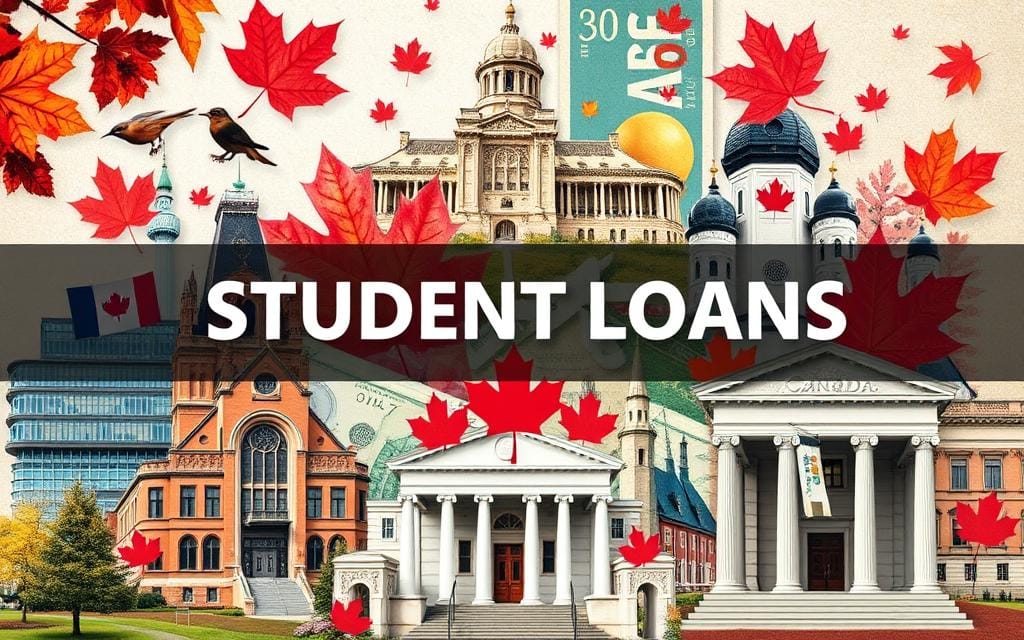advertisement
The average Canadian student graduates with over $28,000 in student loan debt. This fact underscores the importance of understanding student loan options in Canada. Let’s explore what major banks offer for students seeking financial support.
We’ll examine student loans from RBC, TD, and other financial institutions. This guide covers federal, provincial, and private financing options for higher education. Our goal is to help you make informed decisions about your educational funding.

We’ll look at different loan types, repayment options, and extra benefits. This information will help you find the best fit for your financial needs. You’ll gain a clear picture of Canada’s student loan landscape.
Understanding key factors in securing funding is crucial. This knowledge will empower you to navigate the student loan process confidently. Let’s dive into the details of student loans in Canada.
Understanding Student Loans in Canada
Canadian student loans can be complex. Different types of loans and repayment options are available. Let’s explore federal and provincial loans to help you make informed decisions.
Types of Student Loans Available
Canadian students can access various loan options. The main categories are federal student loans and provincial/territorial student loans. Federal loans, like the Canada Student Loan, are available nationwide.
Provincial and territorial loans cater to specific regional needs. These loans offer unique features for local student populations.
Differences Between Federal and Provincial Loans
Federal and provincial loans differ in eligibility, interest rates, and repayment terms. Federal loans have more standardized terms. Provincial loans may offer tailored features for their students.
Understanding these differences helps students choose the best loan for their situation. It’s crucial to consider both financial needs and educational goals.
Repayment Options and Flexibility
After graduation, students enter the repayment phase of their Canadian student loan program. Both federal and provincial loans offer various repayment options. These include fixed and variable interest rates and flexible repayment plans.
Some programs provide loan forgiveness or interest-free periods. These options help students manage their student loan repayment more effectively.
| Loan Type | Interest Rates | Repayment Terms | Flexibility |
|---|---|---|---|
| Federal Student Loans | Prime + 2.5% (fixed) or Prime + 2% (variable) | Up to 15 years | Repayment assistance plans, interest-free periods, loan forgiveness |
| Provincial/Territorial Loans | Varies by province/territory | Varies by province/territory | Repayment assistance, interest-free periods, loan forgiveness (varies) |
Understanding student loan interest rates and repayment options is crucial. It helps students make smart choices about financing their education. This knowledge also aids in developing a sustainable debt management plan.
Major Banks Offering Student Loans
Canadian students have many loan options from major banks. These institutions support post-secondary education with tailored services and financing solutions. They help students reach their academic goals.
Overview of Bank Services for Students
Leading Canadian banks like RBC, TD, CIBC, and BMO offer student-specific products and services. These include private student loans, lines of credit, and student accounts.
Banks work with students to understand their needs. They guide them through student loan consolidation and debt management.
The Role of Canadian Banks in Student Financing
Canadian banks complement the government-backed Canada Student Loan Program. They provide additional financial assistance to students. Banks partner with federal and provincial governments to offer comprehensive borrowing options.
This approach helps students cover tuition, living expenses, and other educational costs. It supports their academic and career goals.
| Bank | Student Loan Offerings | Key Features |
|---|---|---|
| RBC | RBC Student Line of Credit | Flexible borrowing, competitive interest rates |
| TD | TD Student Line of Credit | Customizable loan amounts, simplified application process |
| CIBC | CIBC Student Loans | Specialized loan programs, additional support services |
| BMO | BMO Student Line of Credit | Convenient online application, co-signer options |
Canadian banks support students’ educational dreams across the country. They offer private student loans and financing solutions. This enables students to access resources for their academic and professional goals.
RBC’s Student Loan Offerings
The Royal Bank of Canada (RBC) offers various student loan products. These loans support Canadian students’ educational goals. RBC’s offerings cater to diverse financial needs with flexible options and competitive rates.
Loan Amounts and Interest Rates
RBC’s student loan program allows borrowing up to $40,000 per academic year. The maximum lifetime limit is $350,000. Interest rates are variable and linked to RBC’s prime rate.
Currently, the interest rate on RBC’s student loans starts at prime + 1%. This makes it competitive compared to other major Canadian banks.
Features of RBC’s Student Line of Credit
- Flexible repayment options, with the ability to make interest-only payments during study and up to 15 years for full repayment
- No requirement for a co-signer or collateral, making it accessible for students with limited credit history
- Opportunities to earn rewards and cashback through RBC’s loyalty programs, such as RBC Rewards
- Seamless integration with RBC’s banking and investment services, providing a comprehensive financial ecosystem for students
RBC supports Canadian students’ educational journeys with its loan products. They offer financial flexibility and resources for success. Their competitive rates and features make them popular among students.
| Loan Type | Loan Amount | Interest Rate |
|---|---|---|
| RBC Student Line of Credit | Up to $40,000 per year | Prime + 1% |
| RBC Student Loan | Up to $350,000 lifetime | Prime + 1% |
RBC’s student loans provide financial flexibility for Canadian students. They offer competitive student loan interest rates and tailored features. These loans are popular among students loans Canada banks for financing higher education.
TD Canada Trust Student Loans
TD Canada Trust offers various student loan options to help fund education. Their solutions cater to diverse needs of Canadian students. These include comprehensive loan programs and competitive interest rates.
Loan Programs and Advantages
TD Canada Trust provides two main student loan options. The TD Student Line of Credit allows flexible borrowing as needed. The TD Student Loan offers a fixed-term repayment structure.
Both options feature favorable interest rates and various repayment terms. These are designed to meet individual student needs. TD’s commitment to academic success is a key advantage.
Students can access TD’s financial advice and resources. These help manage finances effectively during and after studies.
Comparing TD’s Rates with Other Banks
| Bank | Student Loan Interest Rates | Repayment Terms |
|---|---|---|
| TD Canada Trust | Prime + 2% to Prime + 4% | Up to 15 years |
| RBC | Prime + 1% to Prime + 3% | Up to 15 years |
| CIBC | Prime + 2% to Prime + 4% | Up to 15 years |
| BMO | Prime + 2% to Prime + 4% | Up to 15 years |
TD’s student loan interest rates are competitive in the Canadian banking market. However, students should compare offers from multiple lenders carefully. This helps find the best fit for their financial needs and goals.
CIBC Student Loans: What to Know
CIBC offers various loan options for post-secondary students in Canada. These loans help fund educational pursuits. CIBC provides insights into loan types and benefits for students.
Types of Loans Specific to CIBC
CIBC’s student loan portfolio caters to diverse financial needs of Canadian students. It includes private student loans Canada and government-backed options. These solutions help students achieve their academic goals.
- CIBC Student Line of Credit: Offers flexible borrowing limits and competitive rates. Students can access funds as needed throughout their studies.
- CIBC Student Loan: Provides fixed-term financing with predictable repayment schedules. This option suits those seeking structured loan arrangements.
- Student loan consolidation options: CIBC allows students to combine multiple loans into one manageable payment plan.
Added Benefits for CIBC Students
CIBC offers additional benefits and support to its student clients. These features help ease financial burdens. They also smooth the journey through post-secondary education.
| Benefit | Description |
|---|---|
| Flexible Repayment Terms | CIBC offers customizable repayment plans, allowing students to tailor their loan repayment schedule to their individual financial circumstances. |
| Specialized Advising | CIBC’s team of financial experts provides personalized guidance to students, helping them navigate the complexities of student financing and identify the most suitable solutions. |
| Interest-Free Grace Period | CIBC student loan borrowers may benefit from a grace period during which no interest accrues, providing a valuable window of relief post-graduation. |
CIBC offers a range of student loan options and benefits. Canadian students can use this information to make smart choices. They can secure financial support to achieve their academic goals.

BMO: Student Loan Solutions in Canada
BMO offers various student loan solutions for Canadian students. These options are flexible and personalized to meet diverse financial needs. BMO’s student loans stand out in the Canadian banking landscape.
Overview of BMO’s Offerings
BMO provides government-backed and bank-specific student loan options. These include traditional student lines of credit and specialized loan programs. Their aim is to help students manage educational expenses effectively.
Features that Stand Out
- Flexible Repayment Options: BMO offers interest-only or full principal and interest payments during studies. They also provide extended repayment periods after graduation.
- Competitive Interest Rates: BMO’s student loan rates are competitive with other major Canadian banks. This ensures affordable financing for students’ educational pursuits.
- Personalized Support: Dedicated representatives guide students through loan application and repayment. They help navigate the complexities of student financing.
- Additional Benefits: BMO may offer financial literacy resources, scholarship opportunities, and career-focused workshops. These add value for student borrowers.
Canadian students can find the financial support they need with BMO’s student loans. The bank is committed to providing a seamless and supportive borrowing experience.
Students can achieve their educational goals while benefiting from BMO’s comprehensive loan solutions.
“BMO’s student loan offerings have been instrumental in helping me manage the financial demands of my education. The flexible repayment options and personalized support from their team have been invaluable.”
– *Sara, University of Toronto Student*
Comparing Student Loan Rates Across Major Banks
Understanding student loan interest rates is crucial for financing your education. These rates can vary significantly among Canadian banks and lenders. This variability can greatly impact the overall cost of your loan.
Interest Rate Variability Explained
Several factors influence student loan interest rates. These include the Bank of Canada’s benchmark lending rate and the lender’s risk assessment. Market conditions also play a role in determining these rates.
Banks like RBC, TD, CIBC, and BMO offer rates that can change over time. This makes it vital for students to stay informed and compare their options regularly.
How to Calculate Total Loan Costs
To determine the total cost of a student loan, consider more than just the interest rate. Look at the loan amount, repayment term, and any additional fees or charges.
A student loan calculator can help estimate the total interest you’ll pay. This tool allows you to make an informed decision about the best financing option for your needs.
| Bank | Student Loan Interest Rates | Repayment Terms | Additional Features |
|---|---|---|---|
| RBC | Prime + 0.5% to 2.5% | Up to 15 years | Line of credit, grace period |
| TD Canada Trust | Prime + 1% to 3% | Up to 15 years | Flexible repayment options |
| CIBC | Prime + 1% to 3.5% | Up to 15 years | Specialized loan programs |
| BMO | Prime + 1% to 3% | Up to 15 years | Discounts for automatic payments |
Grasping student loan interest rates and calculating total costs is vital. This knowledge helps you make smarter decisions about your financing options. It also allows you to minimize the long-term impact of your student debt.
Understanding Loan Application Processes
Applying for Canadian student loans can be challenging. However, knowing the requirements and tips can simplify the process. This guide covers federal and bank loans for students.
General Requirements for Student Loans
To be eligible for student loans in Canada, you’ll typically need to meet the following criteria:
- Be enrolled in a post-secondary education program at an approved institution
- Demonstrate financial need based on your income and expenses
- Maintain satisfactory academic standing throughout your studies
- Be a Canadian citizen, permanent resident, or protected person
- Provide necessary documentation, such as transcripts and proof of enrollment
Tips for a Successful Application
To increase your chances of securing a student loan, consider these helpful tips:
- Start the application process early, allowing ample time for processing
- Gather all required documents and information beforehand to streamline the submission
- Carefully review your application to ensure accuracy and completeness
- Communicate openly with your school’s financial aid office for guidance and support
- Explore both government and private loan options to find the best fit for your needs
Understanding the loan process can boost your confidence. It can help you secure the financing you need for your education. Follow these tips to improve your chances of success.
| Loan Type | Key Requirements | Repayment Options |
|---|---|---|
| Federal Student Loans Canada | Canadian citizenship or permanent residency Enrolled in an eligible post-secondary program Demonstrated financial need | Flexible repayment plans based on income Potential for loan forgiveness or interest relief |
| Bank Student Loans (e.g., RBC, TD, CIBC, BMO) | Enrolled in an approved program Meeting the bank’s credit and income requirements Providing necessary documentation | Fixed or variable interest rates Repayment terms tailored to individual needs |
Alternatives to Traditional Student Loans
Canadian students have options beyond traditional loans for financing higher education. Alternative funding sources can help reduce student debt. Let’s explore government grants, scholarships, and peer-to-peer lending as promising alternatives.
Government Grants and Scholarships
The Canadian government offers various grants and scholarships to help students cover education costs. These can lessen the need for student loan forgiveness Canada or provincial student loans.
Students should apply for programs like the Canada Student Grant and Indigenous Student Bursary. Many universities and private organizations also provide scholarship opportunities to ease financial strain.
Peer-to-Peer Lending Options
Peer-to-peer (P2P) lending platforms are gaining popularity among Canadian students. These platforms connect individual lenders with borrowers, often offering better terms than traditional banks.
P2P lending can provide financing at a lower cost with flexible repayment schedules. This option helps students minimize debt and manage their finances more effectively.
Exploring these alternatives can help students balance affordability and access to higher education. Diversifying funding sources can reduce reliance on debt during and after studies.
| Funding Source | Advantages | Potential Drawbacks |
|---|---|---|
| Government Grants and Scholarships | Reduces reliance on loans Typically don’t require repayment Opportunities for both merit-based and needs-based funding | Highly competitive, with limited availability May have specific eligibility criteria Application process can be time-consuming |
| Peer-to-Peer Lending | Potentially lower interest rates Flexible repayment options Opportunity to build credit history | May require a strong credit profile Regulatory oversight can be less stringent Potential risk of default or platform failure |
These alternative funding sources offer innovative ways for Canadian students to finance their education. They can help manage student debt more effectively and ease financial burdens.
Tips for Managing Student Debt Post-Graduation
Worried about student debt after graduation? Don’t panic! Smart strategies and helpful resources can make managing your finances easier. Let’s explore some effective ways to handle your student debt.
Strategies for Repayment
Create a repayment plan that fits your budget. Look into consolidating your loans to simplify payments and possibly lower interest rates.
Check out the Repayment Assistance Plan from the Government of Canada. Focus on paying off high-interest loans first to reduce your overall debt cost.
Financial Planning Resources for Graduates
Take advantage of financial planning tools designed for recent grads. Try budgeting apps to track your income, expenses, and debt payments.
Ask financial advisors for guidance or attend personal finance workshops. Learn about tax deductions and credits that may apply to your student loan interest.
FAQ
What types of student loans are available in Canada?
Canada offers federal, provincial, and private student loans. These loans cover tuition, living expenses, and other educational costs. Each type has unique features and benefits for students.
What is the difference between federal and provincial student loans?
Federal loans come from the Government of Canada. Provincial loans are offered by individual provinces and territories. Eligibility criteria, interest rates, and repayment terms vary between these loan types.
What repayment options are available for student loans in Canada?
Canada offers various student loan repayment options. These include fixed-term plans, interest-only payments, and income-based repayment. Some programs offer loan forgiveness for graduates in certain fields.
How do major Canadian banks support student financing?
Major Canadian banks offer student loan products to complement government programs. These include student lines of credit and loans with competitive rates. Many offer deferred payment periods and flexible repayment options.
What sets RBC’s student loan offerings apart?
RBC offers flexible borrowing limits and favorable interest rates. Their Student Line of Credit allows students to access funds as needed. This provides greater flexibility and control over student finances.
How do TD Canada Trust’s student loan programs compare to other banks?
TD Canada Trust offers competitive rates and various student loan programs. These include the TD Student Line of Credit and Student GIC Loan. Their products help students build credit history and provide affordable financing options.
What should students know about CIBC’s student loan offerings?
CIBC provides specialized student loan products with flexible repayment terms. They offer loan consolidation and potential perks like waived fees. Students can access CIBC’s suite of banking services with their loans.
How do BMO’s student loan solutions compare to other banks?
BMO offers competitive rates and deferred payment periods. Students can borrow up to the full cost of education. BMO provides financial planning resources to help students manage their finances effectively.
How can students compare student loan interest rates across different banks?
When comparing rates, consider loan type, repayment terms, and additional fees. Interest rates may vary based on credit profile and chosen program. It’s important to review all aspects of each loan offer.
What are the general requirements for obtaining a student loan in Canada?
Canadian student loans require citizenship or permanent residency. Applicants must be enrolled in a post-secondary program. They need to meet academic and financial criteria. Documentation like proof of enrollment and income information is usually required.
What alternatives to traditional student loans are available in Canada?
Alternatives include government grants, scholarships, and peer-to-peer lending. These options can reduce borrowing needs. Some offer more favorable terms or loan forgiveness for certain graduates.
How can students effectively manage their student debt after graduation?
Create a repayment plan and explore loan consolidation options. Use available financial planning resources. Check for eligibility in student loan forgiveness or reduction programs. Stay informed about your loan terms and options.



